
Is involuntary manslaughter a felony? How long is the sentence for manslaughter? What is the manslaughter sentence minimum? In this article, we’re going to cover a comprehensive overview of the legal frameworks governing involuntary manslaughter sentences. Keep reading to gain insights into the complexities of involuntary manslaughter law across various jurisdictions.
In this section, we’ll explore the legal understanding of involuntary manslaughter. Let’s cover the key elements that define this crime, the differences between involuntary and voluntary manslaughter, and the typical penalties associated with a conviction.
Involuntary manslaughter is defined as the unintentional killing of another person without premeditation or malice. It occurs when a person acts with gross negligence or recklessness, leading to someone’s death. Unlike murder, involuntary manslaughter does not involve a deliberate intent to kill, making it a lesser offense but still a serious crime.

When analyzing the legal distinctions between manslaughter vs murder, the element of intent becomes paramount. Murder is characterized by a willful and deliberate intent to kill or inflict grievous bodily harm. In contrast, involuntary manslaughter is defined by the absence of such intent, often arising from reckless or negligent conduct that leads to an unintended death.
According to Statista, the United States recorded 22,900 cases of murder and manslaughter in 2021, underscoring the importance of understanding the nuanced differences, particularly when contrasting voluntary vs involuntary manslaughter within the broader legal framework.
Here are the key points of the manslaughter vs homicide distinction:
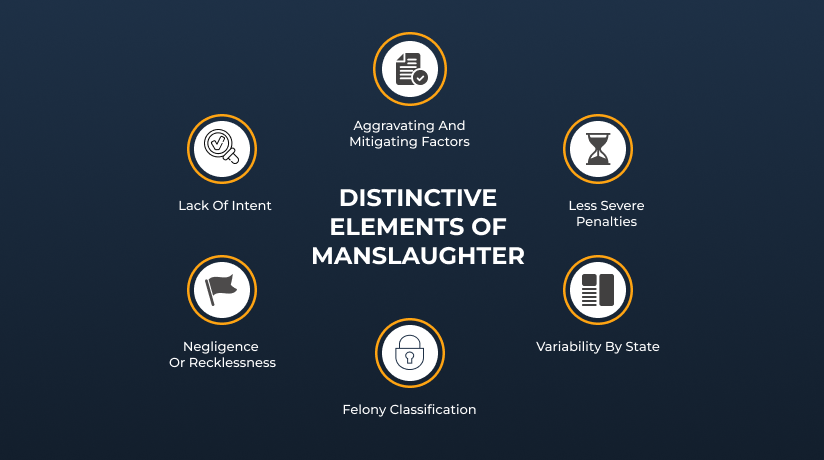
You’ve just learned that involuntary manslaughter has a number of characteristics that distinguish it from murder. Now we will show you what types of manslaughter exist.
This involuntary manslaughter typically involves situations where the defendant’s negligence causes another person’s death. There may not be a direct intention to harm.
The base offense level for criminally negligent involuntary manslaughter is 10. For Criminal History Category I, the guideline range is 6-12 months imprisonment without acceptance of responsibility. With acceptance of responsibility, it drops to 0-6 months.
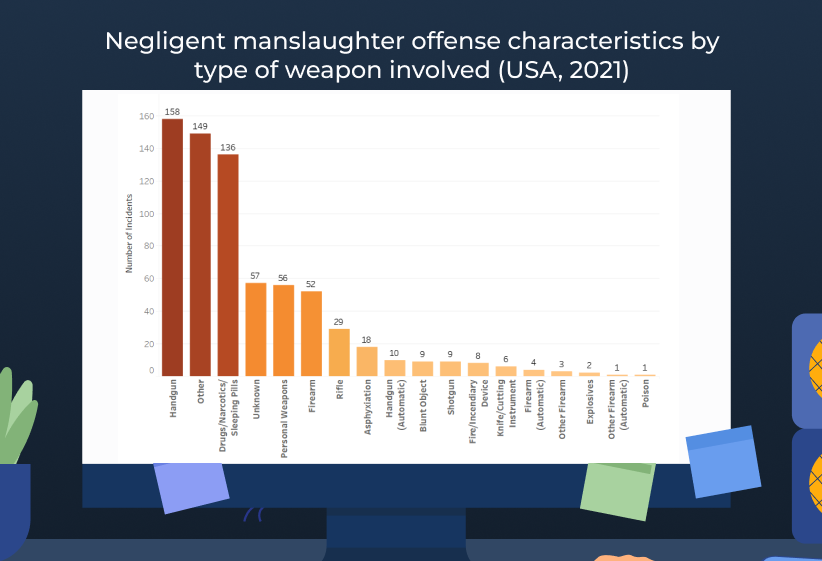
This type occurs when the defendant’s actions, marked by disregard for potential consequences, cause another person’s death.
The base offense level for reckless involuntary manslaughter is 14. Without acceptance of responsibility, the guideline range for Criminal History Category I is 15-21 months. With acceptance, it’s 10-16 months.
Also known as unintentional vehicular manslaughter, this type involves the death of a person due to reckless driving, DUI/OVI or violation of traffic laws.
The base offense level for vehicular manslaughter in the US is 22. Without acceptance of responsibility, the guideline range is 6 years. With acceptance, it’s 10-14 months.
Recklessness is a conscious disregard for a substantial and unjustifiable risk that may result in harm or death. Criminal negligence, on the other hand, involves a failure to recognize or act upon a risk that a reasonable person would have perceived. Both recklessness and criminal negligence can lead to an involuntary manslaughter sentence, depending on the circumstances of the case.
Several factors can contribute to involuntary manslaughter, including but not limited to:
The misdemeanor manslaughter rule is a specific legal doctrine. It states that death during the commission of a misdemeanor or non-dangerous felony becomes involuntary manslaughter. This classification emphasizes the unintended nature of the death, even if the underlying act was a criminal offense.

We’ve explored the differences between manslaughter and other crimes and defined what they entail. Now, let’s continue to understand the penalties and defenses associated with these offenses.
The average involuntary manslaughter sentence varies widely across jurisdictions and depends on several factors, including the nature of the offense, the defendant’s criminal history, and the presence of aggravating or mitigating circumstances.
The typical sentence for involuntary manslaughter is generally up to 2-4 years in prison, although this can vary depending on the specific case and jurisdiction. The average bail is $25,000.
The involuntary manslaughter minimum sentence under federal law typically ranges from 10 to 16 months, which may include probation or a suspended sentence in some jurisdictions.
On the other hand, the maximum sentence for involuntary manslaughter under federal law is 20 years of imprisonment. These sentencing guidelines reflect the seriousness of the offense, although variations may exist between different jurisdictions.
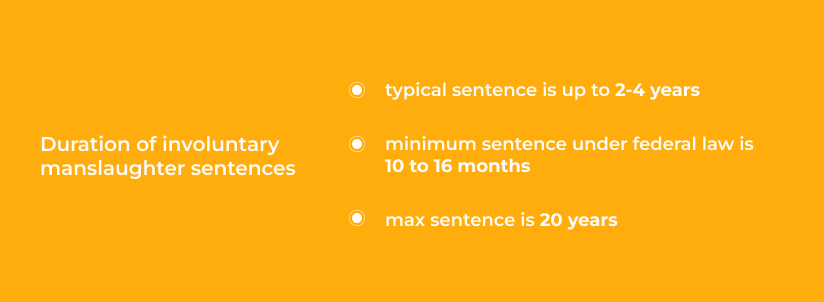
The degrees of involuntary manslaughter often correspond to the level of negligence or recklessness involved, with higher degrees indicating more severe conduct. Penalties may include:
Even if acquitted of involuntary manslaughter, a defendant may still face civil liability in a wrongful death lawsuit. A civil case requires a lower burden of proof, and a finding of liability can result in substantial monetary damages, including payment of emotional distress to the relatives of the deceased. This underscores the complexity of the legal landscape surrounding involuntary manslaughter cases.
Aggravating factors can significantly increase the severity of an involuntary manslaughter sentence, leading to a more serious manslaughter charge in some cases. These factors may include:
Mitigating factors can reduce the severity of an involuntary manslaughter sentence. Examples include:
In involuntary manslaughter cases, the defense of intent is generally inapplicable, as the crime does not require a deliberate intention to kill. This distinguishes involuntary manslaughter from other forms of homicide and shapes the legal strategies used in defense.
Defense strategies in cases that may lead to a reckless involuntary manslaughter sentence may revolve around issues of intent, fairness, and proportionality. Here are some common arguments against these concepts:
These strategies reflect the multifaceted approach a defense might take in a negligence case, tailored to the specific facts, laws, and jurisdiction of the trial.

Check out our article “What Proof Do You Need for a Restraining Order? A Quick Guide“
You’re now familiar with the defenses and penalties for manslaughter. However, legal approaches vary across states. Let’s delve deeper to understand these differences.
Under federal sentencing guidelines, the penalty for involuntary manslaughter is determined by various factors, including the nature of the offense and the offender’s criminal history. The average sentence for manslaughter ranges from 9 to 16 months in prison. The guidelines provide a framework but allow for judicial discretion in individual cases. But how do state laws differ?
These differences are often related to the factors that can influence the severity of the sentence, including considerations such as how many years for manslaughter may be imposed. The variations in state laws reflect the complexity of determining appropriate sentencing based on the unique circumstances of each case.
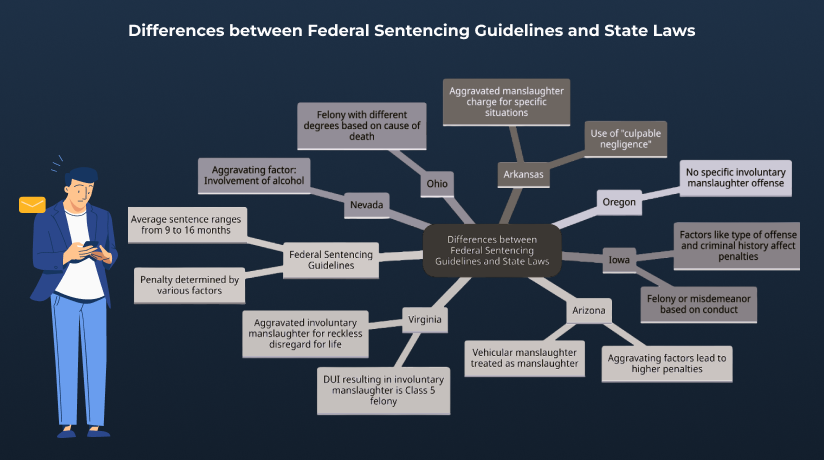
Let’s take the example of a death caused by a car accident. Some states classify it as involuntary or vehicular manslaughter and assign a class by the qualifying crime. The circumstances under which this classification applies can vary.
For example, in California, the involuntary manslaughter sentence depends on the circumstances of the crime:
Some states consider a person guilty of vehicular manslaughter when committing a felony with the vehicle or driving recklessly. If an individual is intoxicated (drunk) behind the wheel and causes a fatal accident, they may be charged with vehicular manslaughter. These rules apply in Arkansas, Kansas, and Wisconsin.
It’s important to note that the specific grounds for sentencing and the factors considered mitigating or aggravating can vary widely from state to state. These variations reflect the unique legal frameworks of each jurisdiction and the circumstances under which involuntary manslaughter occurs.
Sentencing for involuntary manslaughter can differ significantly between states, reflecting variations in legal traditions, public policy, and societal attitudes. These differences may include the classification of the crime (felony vs. misdemeanor), the range of penalties, and the consideration of aggravating and mitigating factors.
Alabama
Class A misdemeanor
1 year
$6,000
Arizona
Class 2 felony
3 to 12 years
$150,000
Arkansas
Class A misdemeanor
4 to 12 years
$750,000
Connecticut
Class C felony
1 to 10 years
$10,000
Iowa
Class 5 Person Felony
34 months
$300,000
Maine
Class A crime
30 years
$50,000
Massachusetts
Involuntary manslaughter
20 years
$1,000
Minnesota
Criminal vehicular homicide
10 to 15 years
$20,000
New York
2nd-degree felony
4 to 15 years
-
Texas
2nd-degree, 1st-degree crimes
5 to 99 years
$10,000
Let’s take a look at examples of involuntary manslaughter cases that provide valuable insights into how laws are applied and interpreted.
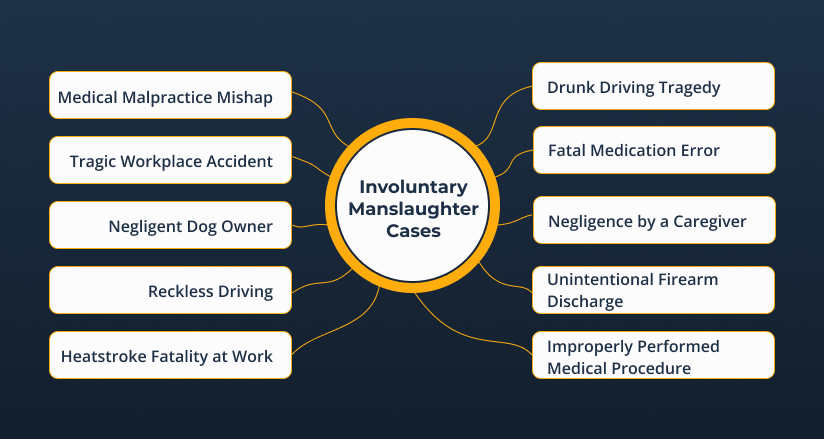
Now you understand the intricacies of manslaughter sentences. Let’s move on to the final crucial aspect – selecting a defense lawyer. Here are some essential considerations:
While an involuntary manslaughter sentence isn’t as grave as one for murder, the consequences remain significant, often leading to incarceration. Consulting a local criminal defense attorney can provide valuable insights into your situation.
The legal frameworks for involuntary manslaughter sentences are complex and multifaceted, but being able to distinguish between the type of crime, knowing your rights to a defense, and the possible penalties in your state can be a major advantage in manslaughter cases.
Do you need experienced criminal defense lawyers to achieve the best results in your defense under investigation? Contact us to get the best lawyer suggestions in the shortest terms.
In most jurisdictions, the answer is affirmative. Involuntary manslaughter is generally considered a felony, a classification that reflects the gravity of causing another person’s death, even if unintentional. As a serious crime, a felony carries significant penalties, including imprisonment, further emphasizing the severity of involuntary manslaughter.
The sentence varies by jurisdiction and specific circumstances, ranging from probation to 8 years or more in prison.
The longest sentence can exceed 20 years, depending on aggravating factors and jurisdiction.
Gross negligence manslaughter typically carries a more severe sentence of up to 18 years, reflecting the higher level of negligence involved.
Jail time for involuntary manslaughter can range from a suspended sentence to 2-4 years in prison.
1st degree involves the full intent to kill another person, while 2nd degree involves lesser negligence, i.e. you know that your actions may result in the death of another person.










